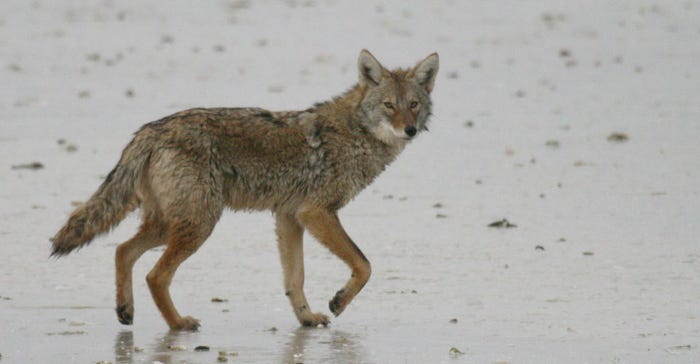May 19, 2020

Charlie Lee knows a thing or 200 about the problems Kansas coyotes can bring livestock producers.
“I probably do 75 to 100 calls a year for coyotes,” says Lee, a 34-year wildlife specialist with the K-State Extension Service. “That’s where I go out and work with the landowners.”
Some have certainly needed his help. Current numbers aren’t available, but in 2010, the USDA National Agricultural Statistics Service showed 1,600 sheep and lambs in Kansas were lost to predators.
These figures showed a loss of 800 Kansas cows and 3,900 calves lost to predators. Lee says coyotes are the most common livestock predator in Kansas. He knows coyotes have pushed some Kansans out of the sheep and goat business.
More coyotes than ever
“We probably have some of the highest coyote densities on the Great Plains,” says Lee, a native of the Leoti area. “Like with all wildlife, it’s about habitat. We have a lot of food and cover, so we have a lot of coyotes.”
A Kansas Department of Wildlife, Parks and Tourism estimate shows that the Kansas coyote population is three times what it was in 1985. Low fur prices are one reason people don’t hunt and trap coyotes as in past decades. They’re also highly adaptable.
Some of the numbers Lee and producers deal with are staggering. In one year, Elk County rancher Greg Pickett trapped, snared or shot 53 coyotes in just a 2-mile square area.
Opportunists
Food for coyotes is usually rodents such as mice, rats and rabbits, Lee says.
“But they’re opportunists,” he says. “If they get a chance at a meal without having to work too hard, they’re going to take it.”
If that easy meal is beef, mutton or goat, they’ll gladly eat it. Lee says coyotes often get blamed for killing livestock when they found it already dead.
Producers need to decide how an animal was killed before assuming they have a predator problem.
Livestock taken down alive will often show signs of a struggle. Blood spray is a good indication the animal’s system was pumping as it was being killed. Tracks and matted grass can be other indications.
Coyotes also get blamed for livestock killed by dogs. It’s often easy to tell the two kinds of kills apart.
“Coyotes are pretty efficient. You can look for bite marks. They’ll usually have a bite mark to the throat, often the lower jaw,” Lee says. “Dogs are more likely to bite and tear and slash.”
Coyotes usually feed heavily on a kill, even to the point of regurgitation, then feed on it some more.
“One coyote can eat 10-15 pounds that way,” Lee says. “Dogs typically don’t eat very much from a kill.”
Many beef-kills are newborn calves, though calves up to nearly 200 pounds have been killed by coyotes. Sheep and goats of about any size can be taken by coyotes.
Preventing predation
Lee encourages producers to make livestock as hard for coyotes to access as possible.
“It helps if you’re calving up near the house where it’s easy for you to get to the cattle and where coyotes won’t want to be,” Lee says. “Deep draws, with a lot of brush, may offer a good windbreak for cattle, but you’re also calving in good coyote habitat.”
Quality net-wire fencing helps protect sheep and goats, though Lee adds he isn’t sure “if there’s such a thing as a coyote- proof fence.”
Guardian animals such as dogs or llamas can make a significant difference. Lee says it’s imperative the animal be started at a young age and be raised with the livestock.
Taking lethal measures
Lee has taught many producers how to remove coyotes from their land. Pickett, the rancher who removed 53, was one of Lee’s students on successful calling, trapping and snaring.
Calling, usually making the sounds of a wounded rabbit or fawn, generally works best in the early fall when naïve pups are first on their own, Lee says.
Trapping and snaring are usually more productive, especially in winter.
“Winter’s the easiest time to trap. Food supply is down, and the coyotes are the hungriest,” Lee says.
Snares are inexpensive, quick to set and usually kill the coyotes fast. They can’t be used, though, if there are guardian animals around because of accidental catches.
Part of Lee’s job is loaning trapping and snaring supplies to landowners. He calls occasionally to check on their success and offer advice. Many succeed.
“Some learn faster than others. Those who have significant problems seem to catch on faster,” Lee says. “It’s either perfect their techniques or continue to lose livestock.”
Lee urges landowners with predation problems to contact their county Extension agent.
Pearce writes from Lawrence.
Read more about:
CoyotesYou May Also Like




